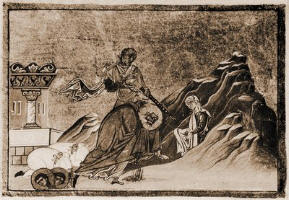
The Works Of Dionysius The Areopagite Volumes 1 & 2
SECTION I
I do not know, O excellent Titus, whether the holy Timothy departed, deaf to some of the theological symbols which were explained by me. But, in the Symbolic Theology, we have thoroughly investigated for him all the expressions of the Oracles concerning God, which appear to the multitude to be monstrous. For they give a colour of incongruity dreadful to the uninitiated souls, when the Fathers of the unutterable wisdom explain the Divine and Mystical Truth, unapproachable by the profane, through certain, certainly hidden and daring enigmas. Wherefore also, the many discredit the expressions concerning the Divine Mysteries. For, we contemplate them only through the sensible symbols that have grown upon them. We must then strip them, and view them by themselves in their naked purity. For, thus contemplating them, we should reverence a fountain of Life flowing into Itself—viewing It even standing by Itself, and as a kind of single power, simple, self-moved, and self-worked, not abandoning Itself, but a knowledge surpassing every kind of knowledge, and always contemplating Itself, through Itself. We thought it necessary then, both for him and for others, that we should, as far as possible, unfold the varied forms of the Divine representations of God in symbols. For, with what incredible and simulated monstrosities are its external forms filled? For instance, with regard to the superessential Divine generation, representing a body of God corporally generating God; and describing a word flowing out into air from a man’s heart, which eructates it, and a breath, breathed forth from a mouth; and celebrating God-bearing bosoms embracing a son of God, bodily; or representing these things after the manner of plants, and producing certain trees, and branches, and flowers and roots, as examples; or fountains of waters, bubbling forth; or seductive light productions of reflected splendours; or certain other sacred representations which explain superessential descriptions of God; but with regard to the intelligible providences of Almighty God, either gifts, manifestations, or powers, or properties, or repose, or abidings, or progressions, or distinctions, or unions, clothing Almighty God in human form, and in the varied shape of wild beasts and other living creatures, and plants, and stones; and attributing to Him ornaments of women, or weapons of savages; and assigning working in clay, and in a furnace, as it were to a sort of artisan; and placing under Him, horses and chariots and thrones; and spreading before Him certain dainty meats delicately cooked; and representing Him as drinking, and drunken, and sleeping, and suffering from excess. What would any one say concerning the angers, the griefs, the various oaths, the repentances, the curses, the revenges, the manifold and dubious excuses for the failure of promises, the battle of giants in Genesis, during which He is said to scheme against those powerful and great men, and this when they were contriving the building, not with a view to injustice towards other people, but on behalf of their own safety? And that counsel devised in heaven to deceive and mislead Achab; and those mundane and meritricious passions of the Canticles; and all the other sacred compositions which appear in the description of God, which stick at nothing, as projections, and multiplications of hidden things, and divisions of things one and undivided, and formative and manifold forms of the shapeless and unformed; of which, if any one were able to see their inner hidden beauty, he will find every one of them mystical and Godlike, and filled with abundant theological light. For let us not think, that the appearances of the compositions have been formed for their own sake, but that they shield the science unutterable and invisible to the multitude, since things all-holy are not within the reach of the profane, but are manifested to those only who are genuine lovers of piety, who reject all childish fancy respecting the holy symbols, and are capable to pass with simplicity of mind, and aptitude of contemplative faculty, to the simple and supernatural and elevated truth of the symbols. Besides, we must also consider this, that the teaching, handed down by the Theologians is two-fold—one, secret and mystical—the other, open and better known—one, symbolical and initiative—the other, philosophic and demonstrative;—and the unspoken is intertwined with the spoken. The one persuades, and desiderates the truth of the things expressed, the other acts and implants in Almighty God, by instructions in mysteries not learnt by teaching. And certainly, neither our holy instructors, nor those of the law, abstain from the God-befitting symbols, throughout the celebrations of the most holy mysteries. Yea, we see even the most holy Angels, mystically advancing things Divine through enigmas; and Jesus Himself, speaking the word of God in parables, and transmitting the divinely wrought mysteries, through a typical spreading of a table. For, it was seemly, not only that the Holy of holies should be preserved undefiled by the multitude, but also that the Divine knowledge should illuminate the human life, which is at once indivisible and divisible, in a manner suitable to itself; and to limit the passionless part of the soul to the simple, and most inward visions of the most godlike images; but that its impassioned part should wait upon, and, at the same time, strive after, the most Divine coverings, through the pre-arranged representations of the typical symbols, as such (coverings) are, by nature, congenial to it. And all those who are hearers of a distinct theology without symbols, weave in themselves a sort of type, which conducts them to the conception of the aforesaid theology.

 Keep Site Running
Keep Site Running